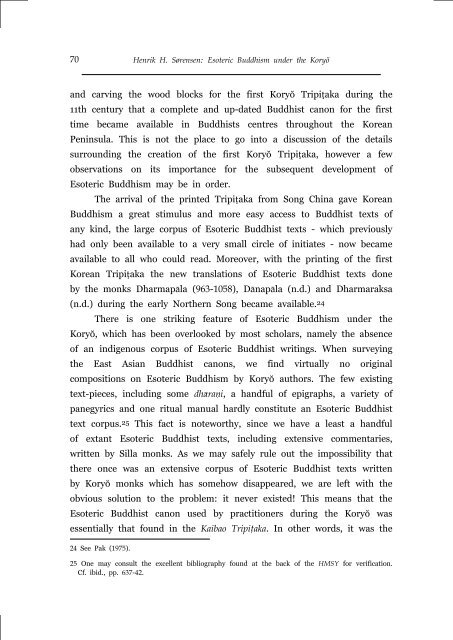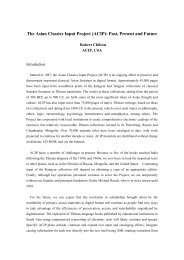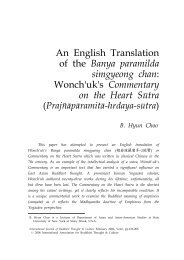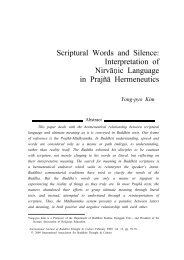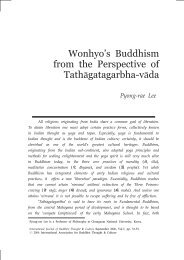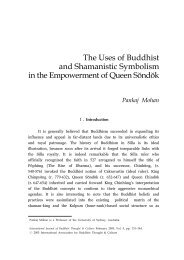Esoteric Buddhism under the KoryÅ in the Light of ... - Buddhism.org
Esoteric Buddhism under the KoryÅ in the Light of ... - Buddhism.org
Esoteric Buddhism under the KoryÅ in the Light of ... - Buddhism.org
Create successful ePaper yourself
Turn your PDF publications into a flip-book with our unique Google optimized e-Paper software.
70<br />
Henrik H. Sørensen: <strong>Esoteric</strong> <strong>Buddhism</strong> <strong>under</strong> <strong>the</strong> Koryŏ<br />
and carv<strong>in</strong>g <strong>the</strong> wood blocks for <strong>the</strong> first Koryŏ Tripi%aka dur<strong>in</strong>g <strong>the</strong><br />
11th century that a complete and up-dated Buddhist canon for <strong>the</strong> first<br />
time became available <strong>in</strong> Buddhists centres throughout <strong>the</strong> Korean<br />
Pen<strong>in</strong>sula. This is not <strong>the</strong> place to go <strong>in</strong>to a discussion <strong>of</strong> <strong>the</strong> details<br />
surround<strong>in</strong>g <strong>the</strong> creation <strong>of</strong> <strong>the</strong> first Koryŏ Tripi%aka, however a few<br />
observations on its importance for <strong>the</strong> subsequent development <strong>of</strong><br />
<strong>Esoteric</strong> <strong>Buddhism</strong> may be <strong>in</strong> order.<br />
The arrival <strong>of</strong> <strong>the</strong> pr<strong>in</strong>ted Tripi%aka from Song Ch<strong>in</strong>a gave Korean<br />
<strong>Buddhism</strong> a great stimulus and more easy access to Buddhist texts <strong>of</strong><br />
any k<strong>in</strong>d, <strong>the</strong> large corpus <strong>of</strong> <strong>Esoteric</strong> Buddhist texts - which previously<br />
had only been available to a very small circle <strong>of</strong> <strong>in</strong>itiates - now became<br />
available to all who could read. Moreover, with <strong>the</strong> pr<strong>in</strong>t<strong>in</strong>g <strong>of</strong> <strong>the</strong> first<br />
Korean Tripi%aka <strong>the</strong> new translations <strong>of</strong> <strong>Esoteric</strong> Buddhist texts done<br />
by <strong>the</strong> monks Dharmap2la (963-1058), D2nap2la (n.d.) and Dharmaraksa<br />
(n.d.) dur<strong>in</strong>g <strong>the</strong> early Nor<strong>the</strong>rn Song became available. 24<br />
There is one strik<strong>in</strong>g feature <strong>of</strong> <strong>Esoteric</strong> <strong>Buddhism</strong> <strong>under</strong> <strong>the</strong><br />
Koryŏ, which has been overlooked by most scholars, namely <strong>the</strong> absence<br />
<strong>of</strong> an <strong>in</strong>digenous corpus <strong>of</strong> <strong>Esoteric</strong> Buddhist writ<strong>in</strong>gs. When survey<strong>in</strong>g<br />
<strong>the</strong> East Asian Buddhist canons, we f<strong>in</strong>d virtually no orig<strong>in</strong>al<br />
compositions on <strong>Esoteric</strong> <strong>Buddhism</strong> by Koryŏ authors. The few exist<strong>in</strong>g<br />
text-pieces, <strong>in</strong>clud<strong>in</strong>g some dh2ra!i, a handful <strong>of</strong> epigraphs, a variety <strong>of</strong><br />
panegyrics and one ritual manual hardly constitute an <strong>Esoteric</strong> Buddhist<br />
text corpus. 25 This fact is noteworthy, s<strong>in</strong>ce we have a least a handful<br />
<strong>of</strong> extant <strong>Esoteric</strong> Buddhist texts, <strong>in</strong>clud<strong>in</strong>g extensive commentaries,<br />
written by Silla monks. As we may safely rule out <strong>the</strong> impossibility that<br />
<strong>the</strong>re once was an extensive corpus <strong>of</strong> <strong>Esoteric</strong> Buddhist texts written<br />
by Koryŏ monks which has somehow disappeared, we are left with <strong>the</strong><br />
obvious solution to <strong>the</strong> problem: it never existed! This means that <strong>the</strong><br />
<strong>Esoteric</strong> Buddhist canon used by practitioners dur<strong>in</strong>g <strong>the</strong> Koryŏ was<br />
essentially that found <strong>in</strong> <strong>the</strong> Kaibao Tripi%aka. In o<strong>the</strong>r words, it was <strong>the</strong><br />
24 See Pak (1975).<br />
25 One may consult <strong>the</strong> excellent bibliography found at <strong>the</strong> back <strong>of</strong> <strong>the</strong> HMSY for verification.<br />
Cf. ibid., pp. 637-42.


